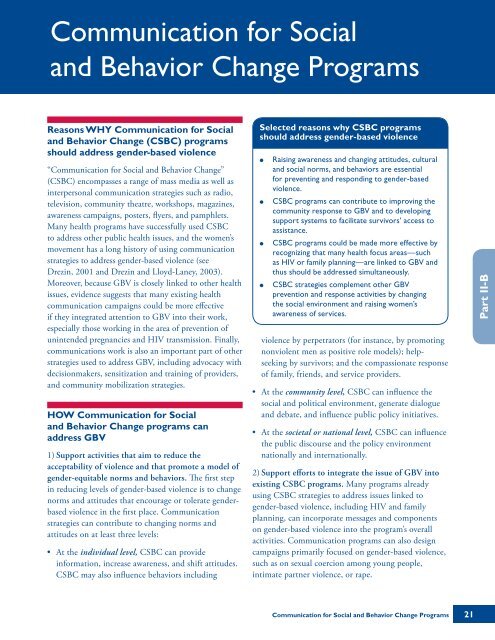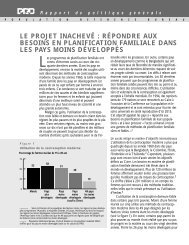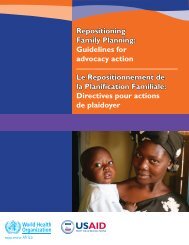addressing gender-based violence through usaid's health ... - IGWG
addressing gender-based violence through usaid's health ... - IGWG
addressing gender-based violence through usaid's health ... - IGWG
Create successful ePaper yourself
Turn your PDF publications into a flip-book with our unique Google optimized e-Paper software.
Communication for Social<br />
and Behavior Change Programs<br />
Reasons WHY Communication for Social<br />
and Behavior Change (CSBC) programs<br />
should address <strong>gender</strong>-<strong>based</strong> <strong>violence</strong><br />
“Communication for Social and Behavior Change”<br />
(CSBC) encompasses a range of mass media as well as<br />
interpersonal communication strategies such as radio,<br />
television, community theatre, workshops, magazines,<br />
awareness campaigns, posters, flyers, and pamphlets.<br />
Many <strong>health</strong> programs have successfully used CSBC<br />
to address other public <strong>health</strong> issues, and the women’s<br />
movement has a long history of using communication<br />
strategies to address <strong>gender</strong>-<strong>based</strong> <strong>violence</strong> (see<br />
Drezin, 2001 and Drezin and Lloyd-Laney, 2003).<br />
Moreover, because GBV is closely linked to other <strong>health</strong><br />
issues, evidence suggests that many existing <strong>health</strong><br />
communication campaigns could be more effective<br />
if they integrated attention to GBV into their work,<br />
especially those working in the area of prevention of<br />
unintended pregnancies and HIV transmission. Finally,<br />
communications work is also an important part of other<br />
strategies used to address GBV, including advocacy with<br />
decisionmakers, sensitization and training of providers,<br />
and community mobilization strategies.<br />
HOW Communication for Social<br />
and Behavior Change programs can<br />
address GBV<br />
1) Support activities that aim to reduce the<br />
acceptability of <strong>violence</strong> and that promote a model of<br />
<strong>gender</strong>-equitable norms and behaviors. The first step<br />
in reducing levels of <strong>gender</strong>-<strong>based</strong> <strong>violence</strong> is to change<br />
norms and attitudes that encourage or tolerate <strong>gender</strong><strong>based</strong><br />
<strong>violence</strong> in the first place. Communication<br />
strategies can contribute to changing norms and<br />
attitudes on at least three levels:<br />
• At the individual level, CSBC can provide<br />
information, increase awareness, and shift attitudes.<br />
CSBC may also influence behaviors including<br />
Selected reasons why CSBC programs<br />
should address <strong>gender</strong>-<strong>based</strong> <strong>violence</strong><br />
●<br />
●<br />
●<br />
●<br />
Raising awareness and changing attitudes, cultural<br />
and social norms, and behaviors are essential<br />
for preventing and responding to <strong>gender</strong>-<strong>based</strong><br />
<strong>violence</strong>.<br />
CSBC programs can contribute to improving the<br />
community response to GBV and to developing<br />
support systems to facilitate survivors’ access to<br />
assistance.<br />
CSBC programs could be made more effective by<br />
recognizing that many <strong>health</strong> focus areas—such<br />
as HIV or family planning—are linked to GBV and<br />
thus should be addressed simultaneously.<br />
CSBC strategies complement other GBV<br />
prevention and response activities by changing<br />
the social environment and raising women’s<br />
awareness of services.<br />
<strong>violence</strong> by perpetrators (for instance, by promoting<br />
nonviolent men as positive role models); helpseeking<br />
by survivors; and the compassionate response<br />
of family, friends, and service providers.<br />
• At the community level, CSBC can influence the<br />
social and political environment, generate dialogue<br />
and debate, and influence public policy initiatives.<br />
• At the societal or national level, CSBC can influence<br />
the public discourse and the policy environment<br />
nationally and internationally.<br />
2) Support efforts to integrate the issue of GBV into<br />
existing CSBC programs. Many programs already<br />
using CSBC strategies to address issues linked to<br />
<strong>gender</strong>-<strong>based</strong> <strong>violence</strong>, including HIV and family<br />
planning, can incorporate messages and components<br />
on <strong>gender</strong>-<strong>based</strong> <strong>violence</strong> into the program’s overall<br />
activities. Communication programs can also design<br />
campaigns primarily focused on <strong>gender</strong>-<strong>based</strong> <strong>violence</strong>,<br />
such as on sexual coercion among young people,<br />
intimate partner <strong>violence</strong>, or rape.<br />
Part II-B<br />
Communication for Social and Behavior Change Programs<br />
21

















